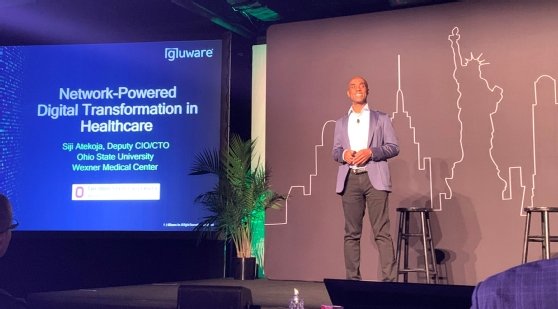
Getty Images
OSU medical center uses automation for digital transformation
Most people think automation will take jobs away. For OSU Wexner Medical Center, network automation helps improve security, simplify tasks for staff and save lives.
The Ohio State University's Wexner Medical Center strives to be a prestigious leader in the medical industry. The task to provide quality healthcare to thousands of patients is a big undertaking, but the medical center looked toward its network to aid in the process.
Wexner Medical Center aims to be one of the top 20 academic health centers in the country and deliver groundbreaking healthcare services, according to Siji Atekoja, deputy CIO and CTO of OSU Wexner Medical Center. To achieve this goal, the organization aims to improve efficiency at a low cost. This is why digital transformation became a priority in Wexner Medical Center's overall strategic plan.
Despite the progress Wexner Medical Center achieved with its digital transformation strategies, Atekoja said one issue remained: network complexity. Wexner's previous network environment included various configurations based on different devices, causing management complexity. IT staff had to manage myriad devices and data with little visibility into the network environment.
In addition to complexity, Atekoja said the organization is actively expanding its facilities and locations, which makes a scalable networking strategy critical for business. During fiscal year 2022 alone, Wexner Medical Center managed over 24,000 employees, 58,000 new patient admissions, over two million outpatient visits and over 165,000 telehealth visits.
The facility's reach continues to increase each year, Atekoja said. A projected increase could amount to thousands more patients and employees for the hospital to support.
This growth, along with the fact that human error caused major network incidents in the past, prompted Wexner Medical Center to implement network automation services from Gluware. According to Atekoja, Gluware's services -- which include products that support security, network automation and digital transformation -- aligned well with Wexner's initiatives.
"The platform aligns with our strategic IT pillars, such as cost reduction, speed to execute, stability and security," he said.
Atekoja said that although Wexner Medical Center put network automation strategies in place, the goal wasn't to replace network professionals with automation -- a common worry about automation. Rather, the goal was to minimize the time professionals spent working on mundane tasks better suited for automation. Instead, network professionals could spend time working on projects that further support the organization's digital transformation goals.

Network security's role in healthcare
Security and resiliency, two widely discussed topics discussed at ONUG, are also top-of-mind for Wexner Medical Center, Atekoja said. The organization implemented a zero-trust framework for a comprehensive security approach. According to Atekoja, a successful security approach can reduce the number of threats that occur and improve network uptime, and in turn reduce mortality rates for the medical center.
Part of that approach, he said, includes the capability to secure patients' application intakes from the beginning. This minimizes the risk of network outages that could interfere with symptom detection. The ability to detect an outage is critical toward the goal of saving lives, he said.
Healthcare IoT-enabled devices
The pandemic gave rise to a new, proactive healthcare paradigm focused on digital care, which is further supported by the use of process automation tools, according to Atekoja. Prior to the pandemic, patients received treatment at a hospital after noticing symptoms, in what Atekoja called a reactive and disconnected approach.
Now, however, process automation tools can combine the patient, provider and employee experience into one connected approach. One use case in particular, which Atekoja called people-driven technology, gives patients their medical results instantaneously through a tool like MyChart.
"Now, the power is shifting back to the patient -- meaning, who owns the data," he said. "That's always been a big question in healthcare. That comes [from] the connected experience."
Atekoja said providers can also equip healthcare workers with all-in-one healthcare IoT-enabled devices that support multiple use cases. One device can include many functionalities, such as making phone calls, aiding lab administration and measuring vitals.
Network automation deployment strategy
These use cases show the potential of network automation within a digital transformation strategy. Wexner Medical Center has yet to fully roll out its network automation strategy but is using a three-phase journey. Atekoja said those three phases are the following:
- Phase 1: Understand the network environment. Network professionals must understand the different configurations in the network environment to deduce which tasks to automate and understand network behavior.
- Phase 2: Expand automation. When network professionals understand the environment and recognize which configurations to automate, teams can push out automation controls to devices.
- Phase 3: Large-scale automation deployment. Network process automation tools, like the Robotic Process Automation (RPA) product from Gluware, helps network professionals deploy process automation at large.
Wexner Medical Center has currently deployed more than 100 RPAs, Atekoja said, and is working toward an end-to-end network automation strategy.
During the process of deploying automation into the network, Atekoja said organizations should recognize that different applications and tools provide different value. When network professionals use an automation tool that focuses on only one aspect of the network, they're likely to analyze one specific area rather than looking at the whole scope. Atekoja said analyzing the automated networking platform from end to end helps teams accurately monitor network performance.









